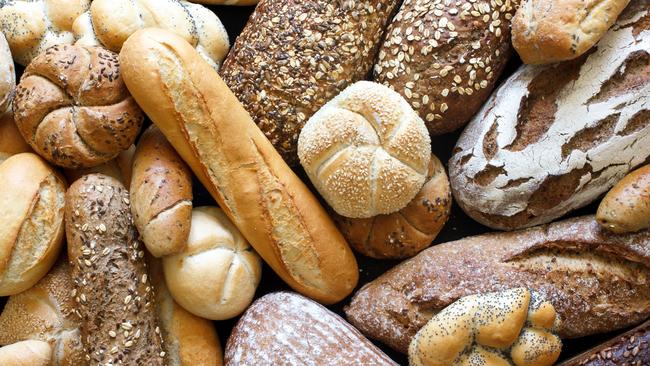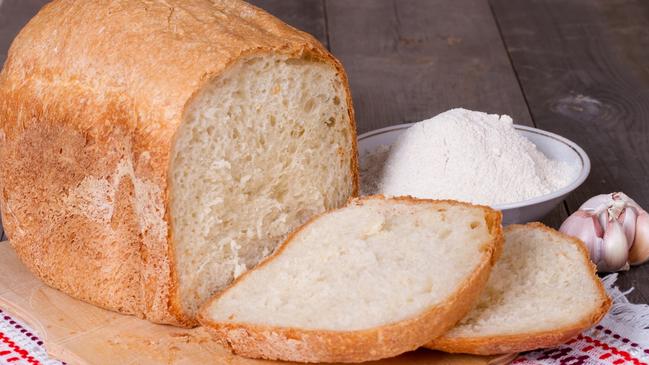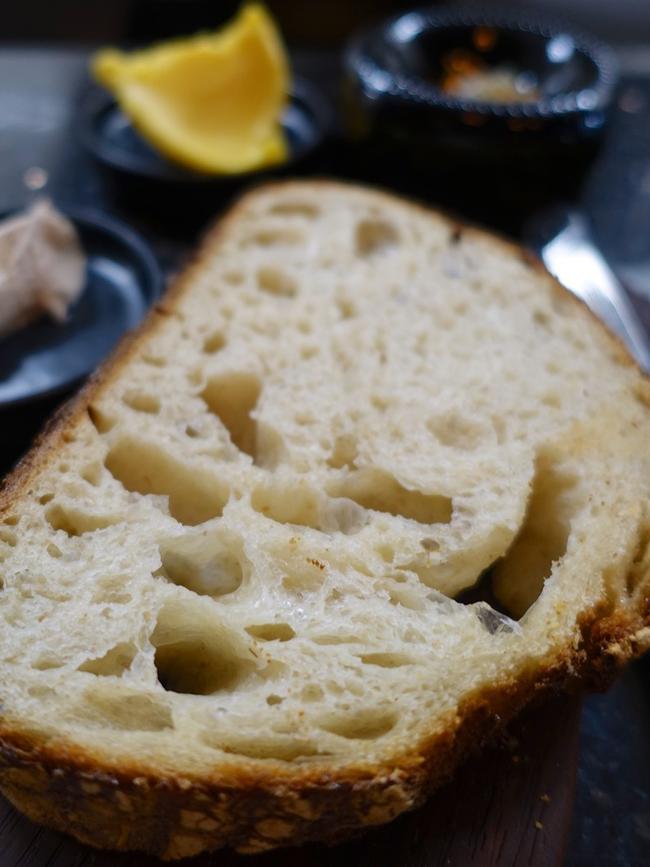What you should be looking for when buying bread
Are wraps any healthier than normal bread? What’s the difference between wholegrain, and multigrain? Bread might have earned itself a bad rap of late, but it can still be a healthy choice — you’ve just got to pick the right one.

Lifestyle
Don't miss out on the headlines from Lifestyle. Followed categories will be added to My News.
Soy and linseed, pumpkin seed, high fibre, low carb — a visit to your local bakery or trip to the supermarket to buy a humble loaf of bread has become more confusing than trying to do a Rubik’s cube in the dark, with more varieties available than ever.
But finding the right bread for you and your family doesn’t have to be as complicated as it may seem.
Nutritionist and dietitian Rachael Bradford says bread can be a healthy choice, it’s just a matter of understanding what to look for.

WHITE BREAD
“White bread has the lowest fibre and nutrient density, as it is made with white flour,” says Bradford.
That basically means that all the goodness from the high fibre bran layer and the high nutrient germ layer of the grain kernel has been stripped away, leaving behind a product low in micronutrients and overall nutrition.
“Some white breads now have ‘extras’ added to (them), it may be some vitamins, minerals or fibre — however it does not have the nutritious quality of wholegrains,” says Bradford.
“White bread has a high glycaemic index that means it can cause your blood glucose levels to rise more quickly and produce peaks in insulin levels.”
What to buy?
While it may taste great as part of an egg and lettuce sandwich and is essential to the best fairy bread, white bread should not be on the menu from a nutritional standpoint, says Bradford.
“Family members will eat the bread that is available at home (so) make the switch,” she says. “Opt for wholegrain or wholemeal bread rather than white bread. If you must choose white bread, at least go for a white, high-fibre variety.”
She recommends looking for less than 400mg sodium per 100g and at least 3g fibre per serve (2 slices).
WHOLEMEAL
“Bread made on wholemeal wheat flour technically uses the whole grain, but the grain is milled down into a finer texture,” says Bradford.
“It does include all parts of the grain, and has a good fibre and nutrient content. Some people prefer the smoothness of wholemeal bread, rather than the wholegrain bread.”
What to buy?
“Some wholemeal breads may have a combination of white and wholemeal flour, so look for one that just uses wholemeal wheat flour with the highest fibre content,” the dietitian says.

MULTIGRAIN
Multigrain bread is made with white flour and has grains added into the bread mix.
“This is a popular choice for children as they see it as a white bread, however it has the benefits of having some softened kibbled or cracked wholegrains present,” says Bradford.
It also has a slightly lower GI than white bread, thanks to the addition of grains.
What to buy?
Try to look for breads that have added fibre, but better yet, choose a wholegrain bread instead.
WHOLEGRAIN
The difference between wholegrain and multigrain is that wholegrain contains the entire grain — the bran (outer layer), endosperm (middle starch layer) and germ (nutrient-rich core). The wholegrain can either be as the intact grain or separated and milled and returned into the bread. As all parts of the grain are returned, the nutrient profile is the same.
“Generally speaking, the more kibbled grains or bits in the bread, the better it will be for you,” says Bradford.
“Bread that contains wholegrain flour with kibbled or intact wholegrains is a nutritious and healthy option.”
It’s a good source of protein, fibre, vitamins and minerals and also has a lower GI as the grains take longer to break down in the gut.
What to buy?
Bradford says we should be looking for the word “wholegrain” on the label or high up in the ingredient list, with at least 50 per cent wholegrains.
“The dense wholegrain bread that is darker with kibbled grains within the loaf is the more nutritious choice,” she says.
Always be sure to check the fibre content as well, aiming for at least 7g per serve (2 slices).
SOY AND LINSEED
Made by adding soy grits, soy flour and linseeds to a white wheat flour, these breads are a good source of fibre, omega-3 and are naturally higher in fat, which can make them quite filling compared to other breads.
“Phytoestrogens found in soy and linseed soy products are thought to relieve menopausal symptoms and protect against heart disease and certain cancers,” Bradford says.
However, the soy found in bread is minimal compared to soy milk or tofu.
What to buy?
If you are watching your weight, read nutritional labels as some brands can have up to a third more kilojoules than others.
READ MORE:
MELBOURNE’S BEST PASTA IS HERE
ITALIAN RESTAURANTS YOU HAVE TO TRY
RYE
Made with flour from the rye grain, instead of wheat grain, rye bread is popular in Scandinavia and Europe, but still contains gluten.
Dark rye breads, including pumpernickel and schinkenbrot, are quite distinct in flavour and have a dense, often slightly chewy texture.
“It has a low GI and is digested more slowly in the gut,” Bradford says.
Light rye bread is a combination of dark rye flour and white wheat flour to give it a lighter texture, more akin to the regular breads we are used to.
What to buy?
Look for the dark rye bread such as pumpernickel or 100 per cent rye bread, which have high levels of soluble fibre to help reduce cholesterol, and are packed with magnesium, which helps control blood pressure.
SOURDOUGH
Sourdough bread is made using a “starter” of wheat and water, filled with yeast and bacteria to cause fermentation to take place. This culture gives the bread the sour taste.

“It is low GI and will keep you feeling fuller than white bread, however, it is low in fibre and does not contain wholegrains,” says Bradford.
“It is thought that the slow fermentation process used in traditional sourdough methods allows the yeast to break down the starches and the proteins in the bread, making it more gut-friendly for people with gut sensitivities.”
What to buy?
Bradford recommends buying traditional sourdough made by sourdough bakeries as they will use perfect temperatures and times to allow the bread to rise.
TURKISH BREAD
Made with white wheat flour and canola oil, this is a high GI, low fibre, low nutrient bread, with a fat content that can be up to 10g per 100g depending on the brand.
“Shelf Turkish bread will have 282 calcium propionate (mould retardant) added to it,” Bradford warns.
What to buy?
“Use more occasionally if needed with socialising or entertaining,” Bradford says. “Don’t choose it as a regular bread as it does not contain wholegrains.”
BAGELS
Typically made with white flour and either a malt syrup or brown sugar, these bread rings have a high refined carbohydrate content, are high GI with limited nutrients and an overall low nutritional quality, says Bradford.
What to buy?
“Choose a wholegrain bread roll instead,” Bradford suggests.
WRAPS
From low GI to gluten-free and wholegrain, there is a huge range of wraps now available, but Bradford says you need to beware of the amount of energy you are consuming with them.
“Depending on the size of the wrap, they can equate to two to three slices of regular bread,” she says, also adding that the salt content varies significantly between different brands.
What to buy?
“Choose smaller sizes, wholegrain or wholemeal wraps,” she says, particularly recommending wholegrain wraps containing barley, which are a newcomer to shelves with more resistant starch, which can improve insulin sensitivity.
On the nutritional label, she says to look for less than 500mg per 100g of salt, less than 5g per 100g of fat and more than 4g of fibre per serve.
GLUTEN-FREE BREAD
Designed for those with Coeliac disease or gluten sensitivity, GF breads tend to use the likes of rice flour, tapioca flour, potato flour and almond meal instead of wheat flour.
“Gluten-free flour does not have folate added to it, so naturally these breads are lower in folate,” Bradford says. “Gluten-free breads are usually moderate-high in glycaemic index.”
What to buy?
“Choose a gluten-free bread with naturally wholegrain gluten-free flour and with added seeds or gluten-free grains added,” Bradford says.

SPROUTED BREAD
“Sprouted breads are a delicious newcomer to the bread market and use seeds and grains, rather than flour,” Bradford says.
“The seeds and grains are activated in water and sprouted at the right temperature for several days and then ground down to make a nutrient-dense bread mixture. They are an excellent source of fibre, nutrients, protein, antioxidants and a natural source of prebiotics.”
Prebiotics are non-digestible carbohydrates that support digestive health and provide a fuel for our beneficial gut bacteria.
What to buy?
Available in a range of varieties including rye, spelt, sunflower seed and hemp, they are all good, nutritious options.
“People with digestive issues may benefit from choosing sprouted breads,” she says.
FIBRE-ENRICHED BREAD
Fibre-enriched breads often will have soluble fibre or resistant starches added to the bread.
What to buy?
“Examples are Inulin or Hi-Maize that act as prebiotic fibres in the gut and are a fuel source for beneficial gut bacteria in the bowel,” Bradford says.
LOW FODMAP BREAD
One of the main sources of trouble for those diagnosed with Irritable Bowel Syndrome is Fructans (Fructo-oligosaccharides), the “O” in FODMAP. Dietary sources of Fructo-oligosaccharides include items that contain wheat, such as bread. Low FODMAP breads therefore are free from these fructans.
What to buy?
“People with wheat intolerance only need to avoid wheat and rye for their digestive complaints,” Bradford says. “They can choose a low FODMAP bread such as Baker’s Delight LowFOD™ loaf or spelt sourdough loaf that are very palatable and light in texture.”
OVERALL ADVICE
Don’t let the hype surrounding keto and low-carb diets turn you off bread, just be smart about your choices, opting for wholegrain options instead of nutritionally low, white-based varieties.
“Bread is an economical and easy way to include wholegrains in your diet,” Bradford says.
“Bread made from wholegrain flour is nutritious and enjoyable for the whole family. It is a good source of carbohydrate and fibre, thiamine, riboflavin, niacin, iron, selenium, magnesium and vitamin E.”
But she says it shouldn’t be the only source of wholegrains in your diet, also recommending a good mix of others such as teff, freekeh, oats, brown rice, quinoa, rye, triticale and barley.
And when buying bread, she says those from a bakery or baked in store are always better than shelf bread.
“Freshly baked bread has fewer preservatives, particularly (mould retardant) calcium propionate 282,” she says.
